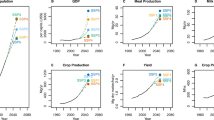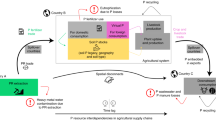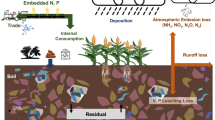Abstract
The industrial world has converted inert soil and atmospheric nutrients into reactive fertilizer flows that endanger water quality, biodiversity and climate. Simultaneously, poor nations starve because of the shortage of these nutrients in agricultural soils. Here we propose a redistribution of accumulated nutrients to enhance food security while counteracting the current degradation of critical Earth system processes. Residue and sediment nutrients could be processed and transported to food-insecure regions through the opposite logistics used to ship rock phosphate across the globe. Financing through trading accumulated rights could trigger the required innovations in processing, logistics and thinking. Such a socially just ‘one Earth currency’ could leverage a transformation towards resilience, equity and dignity across the critical Earth system processes.
This is a preview of subscription content, access via your institution
Access options
Access Nature and 54 other Nature Portfolio journals
Get Nature+, our best-value online-access subscription
$29.99 / 30 days
cancel any time
Subscribe to this journal
Receive 12 digital issues and online access to articles
$119.00 per year
only $9.92 per issue
Buy this article
- Purchase on Springer Link
- Instant access to full article PDF
Prices may be subject to local taxes which are calculated during checkout




Similar content being viewed by others
References
Steffen, W. & Stafford Smith, M. Planetary boundaries, equity and global sustainability: why wealthy countries could benefit from more equity. Curr. Opin. Environ. Sustain. 5, 403–408 (2013).
Kahiluoto, H., Kuisma, M., Kuokkanen, A., Mikkilä, M. & Linnanen, L. Local and social facets of planetary boundaries: right to nutrients. Environ. Res. Lett. 10, 104013 (2015).
Kahiluoto, H., Kuisma, M., Kuokkanen, A., Mikkilä, M. & Linnanen, L. Taking planetary nutrient boundaries seriously: can we feed the people? Glob. Food Sec. 3, 16–21 (2014).
Steffen, W. et al. Planetary boundaries: guiding human development on a changing planet. Science Express (15 March 2015).
Breitburg, D. et al. Declining oxygen in the global ocean and coastal waters. Science 359, 6371 (2018).
Thompson, R. L. et al. Acceleration of global N2O emissions seen from two decades of atmospheric inversion. Nat. Clim. Change 9, 993–998 (2019).
Sanchez, P. A. & Swaminathan, M. S. Hunger in Africa: the link between unhealthy people and unhealthy soils. Lancet 365, 442–444 (2005).
Lagi, M., Bertrand, K. Z. & Bar-Yam, Y. in Conflict and Complexity: Understanding Complex Systems (eds Fellman, P. V. et al.) 249–259 (Springer, 2015).
Zhang, X. et al. Managing nitrogen for sustainable development. Nature 528, 51–59 (2015).
Geels, F. W. Technological transitions as evolutionary reconfiguration processes: a multi-level perspective and a case-study. Res. Policy 31, 1257–1274 (2002).
Potter, P., Ramankutty, N., Bennett, E. M. & Donner, S. D. Characterizing the spatial patterns of global fertilizer application and manure production. Earth Interact. 14, 002 (2010).
Liu, J. et al. A high-resolution assessment on nitrogen flows in cropland. Proc. Natl Acad. Sci. USA 107, 8035–8040 (2010).
MacDonald, G. K., Bennett, E. M., Potter, P. A. & Ramankutty, N. Agronomic phosphorus imbalances across the world’s croplands. Proc. Natl Acad. Sci. USA 108, 3086–3091 (2011).
Mueller, N. D. et al. Closing yield gaps through nutrient and water management. Nature 490, 254–257 (2012).
Sanchez, P. A. et al. in Replenishing Soil Fertility in Africa (eds Buresh, R. J. et al.) 1–46 (SSSA Special, 1997).
Van Meter, K. J., Basu, N. B., Veenstra, J. J. & Burras, C. L. The nitrogen legacy: emerging evidence of nitrogen accumulation in anthropogenic landscapes. Environ. Res. Lett. 11, 035014 (2016).
Bouwman, A. F. et al. Lessons from temporal and spatial patterns in global use of N and P fertilizer on cropland. Sci. Rep. 7, 40366 (2017).
Sattari, S. Z., Bouwman, A. F., Giller, K. E. & van Ittersum, M. K. Residual soil phosphorus as the missing piece in the global phosphorus crisis puzzle. Proc. Natl Acad. Sci. USA 109, 6348–6353 (2012).
MacDonald, G. K. & Bennett, E. M. Phosphorus accumulation in Saint Lawrence River watershed soils: a century-long perspective. Ecosystems 12, 621–635 (2010).
Tan, Z. X., Lal, R. & Wiebe, K. D. Global soil nutrient depletion and yield reduction. J. Sustain. Agric. 26, 123–146 (2005).
Meier, H. E. et al. Impact of climate change on ecological quality indicators and biogeochemical fluxes in the Baltic Sea: a multi-model ensemble study. Ambio 41, 558–573 (2012).
Ekholm, P. & Mitikka, S. Agricultural lakes in Finland: current water quality and trends. Environ. Monit. Assess. 116, 111–135 (2006).
Savchuk, O. P. & Wulff, F. Long-term modeling of large-scale nutrient cycles in the entire Baltic Sea. Hydrobiologia 629, 209–224 (2009).
Carpenter, S. R. Eutrophication of aquatic ecosystems: bistability and soil phosphorus. Proc. Natl Acad. Sci. USA 102, 10002–10005 (2005).
Stocking, M. A. Tropical soils and food security: the next fifty years. Science 302, 1356–1359 (2003).
The State of Food Security and Nutrition in the World 2020: Building Climate Resilience for Food Security and Nutrition (FAO, IFAD, UNICEF, WFP, WHO, 2020).
World Population Prospects 2019 Highlights (UN Department of Economic and Social Affairs, 2019).
Jasinski, S. M. Mineral Commodity Summaries: Phosphate Rock (US Geological Survey, 2021).
Agbahey, J. U. I., Luckmann, J., Grethe, H. & Alemub, B. A. How do domestic policies affect the integration of Ethiopian fertiliser markets with world markets? J. Agric. Rural Dev. Trop. Subtrop. 116, 213–226 (2015).
Rimhanen, K. & Kahiluoto, H. Management of harvested carbon in smallholder mixed farming in Ethiopia. Agric. Syst. 130, 13–22 (2014).
Lassaletta, L. et al. Food and feed trade as a driver in the global nitrogen cycle: 50-year trends. Biogeochemistry 118, 225–241 (2014).
Sillman, J. et al. A life cycle environmental sustainability analysis of microbial protein production via power-to-food approaches. Int. J. Life Cycle Assess. 25, 2190–2203 (2020).
Van Dijk, K. C., Lesschen, J. P. & Oenema, O. Phosphorus flows and balances of the European Union member states. Sci. Total Environ. 542, 1078–1093 (2016).
Kahiluoto, H. et al. Potential of agrifood wastes in mitigation of climate change and eutrophication—two case regions. Biomass Bioenergy 35, 1983–1994 (2011).
Hedley, C. The role of precision agriculture for improved nutrient management on farms. J. Sci. Food Agric. 95, 12–19 (2015).
Conley, D. J. et al. Tackling hypoxia in the Baltic Sea: is engineering a solution? Environ. Sci. Technol. 43, 3407–3411 (2009).
Van Loon, M. P. et al. Impacts of intensifying or expanding cereal cropping in sub-Saharan Africa in coming decades on greenhouse gas emissions and food security. Glob. Change Biol. 25, 3720–3730 (2019).
Wilkinson, R. G. & Pickett, K. E. Income inequality and social dysfunction. Annu. Rev. Sociol. 35, 493–511 (2009).
Raworth, K. Oxfam Discussion Paper (Oxfam, 2012).
van den Berg, N. J. et al. Implications of various effort-sharing approaches for national carbon budgets and emission pathways. Climatic Change 162, 1805–1822 (2020).
McDermott, M., Mahanty, S. & Schreckenberg, K. Examining equity: a multidimensional framework for assessing equity in payments for ecosystem services. Environ. Sci. Policy 33, 416–427 (2013).
Ostrom, E. Polycentric systems for coping with collective action and global environmental change. Glob. Environ. Change 20, 550–557 (2010).
Rawls, J. A Theory of Justice (Belknap, 1971).
McCrudden, C. Human dignity and judicial interpretation of human rights. Eur. J. Int. Law 19, 655–724 (2008).
Ayala, A. & Meier, B. M. A human rights approach to the health implications of food and nutrition security. Public Health Rev. 38, 10 (2017).
Erisman, J. W. et al. in The European Nitrogen Assessment (eds Sutton, M. A. et al.) 9–31 (Cambridge Univ. Press, 2011).
Abiven, S., Schmidt, M. W. I. & Lehmann, J. Biochar by design. Nat. Geosci. 7, 324–327 (2014).
Ridder, M., de Jong, S., Polchar, J. & Lingemann, S. Risks and Opportunities in the Global Phosphate Rock Market: Robust Strategies in Times of Uncertainty (Hague Centre for Strategic Studies, 2013).
Sutton, M. A. et al. Too much of a good thing. Nature 472, 159–161 (2016).
Sobota, D. J., Compton, J. E., McCrackin, M. L. & Singh, S. Cost of reactive nitrogen release from human activities to the environment in the United States. Environ. Res. Lett. 10, 025006 (2015).
Goulder, L. H. & Schein, L. R. Carbon taxes versus cap and trade: a critical review. Clim. Change Econ. 4, 1350010 (2013).
Tradeable Permits: Policy Evaluation, Design and Reform (OECD, 2004).
Chen, Y., Wang, C., Nie, P. & Chen, Z. A clean innovation comparison between carbon tax and cap-and-trade system. Energy Strategy Rev. 29, 100483 (2020).
Framework for a Nutrient Quota and Credits’ Trading System for the Contracting Parties of HELCOM in Order to Reduce Eutrophication of the Baltic Sea (Green Stream Network, 2008).
Moberg, E. et al. Combined innovations in public policy, the private sector and culture can drive sustainability transitions in food systems. Nat. Food 2, 282–290 (2021).
Christensen, C. M., McDonald, R., Altman, E. J. & Palmer, J. E. Disruptive innovation: an intellectual history and directions for future research. J. Manage. Stud. 55, 7 (2018).
Henderson, R. Reimagining Capitalism in a World on Fire (Public Affairs, 2020).
Acknowledgements
We thank A. Törmälä for creating the artwork.
Author information
Authors and Affiliations
Contributions
All authors contributed to the conceptualization and the writing of this paper.
Corresponding author
Ethics declarations
Competing interests
The authors declare no competing interests.
Additional information
Peer review information Nature Food thanks Will Brownlie, Zdravka Tzankova and the other, anonymous, reviewer(s) for their contribution to the peer review of this work.
Publisher’s note Springer Nature remains neutral with regard to jurisdictional claims in published maps and institutional affiliations.
Rights and permissions
About this article
Cite this article
Kahiluoto, H., Pickett, K.E. & Steffen, W. Global nutrient equity for people and the planet. Nat Food 2, 857–861 (2021). https://doi.org/10.1038/s43016-021-00391-w
Received:
Accepted:
Published:
Issue Date:
DOI: https://doi.org/10.1038/s43016-021-00391-w
This article is cited by
-
Food-Energy Integration in Primary Production and Food Processing Results in a More Equal Distribution of Economic Value Across Regional Food Systems: Nordic Case Study from Circular Perspective
Circular Economy and Sustainability (2023)
-
Advancing sustainable agriculture: Enhancing crop nutrition with next-generation nanotech-based fertilizers
Nano Research (2023)



